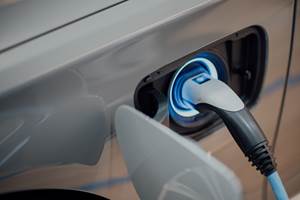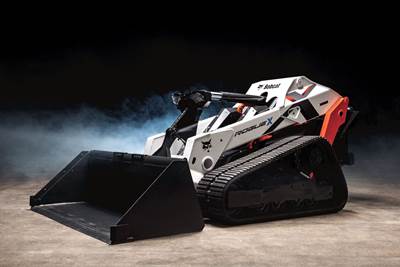on Dodge compact CUV performance, composite-intensive cars, & creating better batteries
The Dodge Hornet is ready to roll. . .Gordon Murray making a few supercars. . .the price of potholes. . .battery chemistries. . .VW’s econo EV concept. . .
Share
Read Next
On the Dodge Hornet
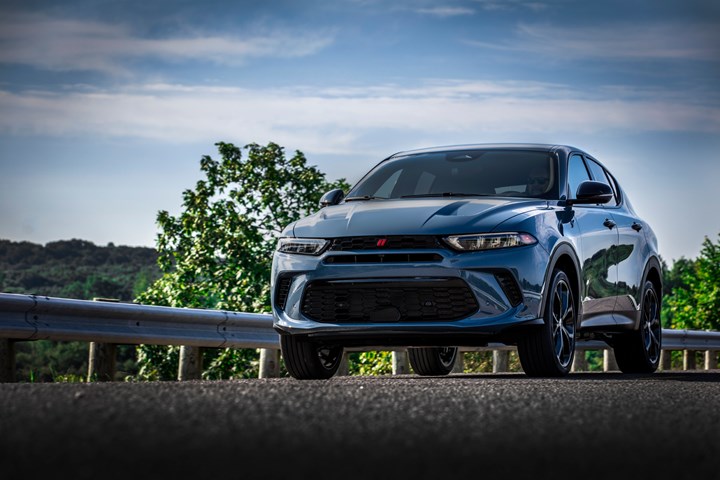
Compact crossovers have massive market appeal. So Dodge figures that it simply needs to add some comparatively affordable muscle to the category. (Image: Dodge)
Comscore, a research organization that compiles number about things like box office earnings and the number of people watching programs on TV, also has a comprehensive assessment of the number of people who are engaging with companies of seemingly all types on social media, including Facebook, Twitter and Instagram.
One of those categories is “Automotive—Automobiles & Manufacturers.”
In its recent findings it found that the top five companies or brands in the social space are:
- Lamborghini
- Porsche
- BMW M
- Rolls Royce
And. . .
- Dodge
That’s right, the brand behind the Brotherhood of Muscle is in the mix with brands that, while they may make some awfully fast vehicles, don’t have the same sort of adrenaline-fueled performance of a Dodge Challenger Black Ghost or a Dodge Charger King Daytona.
People love their Dodges or lust after having one in their garage. (Note that the special edition Black Ghost has an MSRP of $99,315 and the King Daytona $98,420, so there is probably more lusting than affording going on.)
Yes, yes, the Charger and the Challenger are going out of production.
Yes, yes, the Durango is a rather, um, mature vehicle.
Yes, yes, the Dodge Charger Daytona SRT Concept is pointing to the direction of an electric future.
But Dodge is still about standing on the right pedal until there is nothing left.
Performance. That’s been the brand’s ticket to ride for the past decade.
>>>
“They’re bringing muscle back the right way and these are my kind of cars.”—Vin Diesel, May 2017
>>>
Think about this: some might think that “muscle cars” are retro (consider the quote just above) and because Dodge is a purveyor of muscle cars, those cars must be retro.
But in 2000, when the then-Chrysler Corporation came out with what was an unapologetically retro-styled vehicle, the PT Cruiser, it had a Chrysler badge.
Not Dodge. It isn’t about retro cars. Muscle, yes. The past, no.
Dodge isn’t about looking back.
Well, the rearview mirror, perhaps, but. . . .
>>>
While Performance continues to be what Dodge is about, there is a recognition that things have changed and are changing in the market, as in:
- The compact utility segment is big and getting bigger.
- Electrified powertrains are also growing in popularity (and some might say necessity).
And so Dodge is bringing something new to the scene.
Chris Wincek, senior manager, Dodge UV Product, says that the Performance pillar stands strong. But they are adding a second element: Style.
What’s more, were Dodge just to come out with a compact utility vehicle that was merely competitive, at this stage of the game that would probably be like driving on a drag strip covered with speed bumps. Not the sort of thing that would generate the kind of interest that things like Hellcats do.
So to enter that space they’ve developed the Dodge Hornet compact utility.
There are two variants:
- Hornet R/T
- Hornet GT
All vehicles come standard as all-wheel drive.
The R/T is the hybrid There is a 1.3-liter turbocharged engine and, on the rear axle, a 121-hp electric induction motor. The R/T also features a 44-hp belt-starter generator that adds to the torque when getting on the throttle.
It has a 15.5-kWh lithium-ion battery pack that provides an all-electric range of >30 miles (although that range is going to be greatly mitigated for those who use another feature we’ll get to momentarily).
But the point of the Hornet R/T is not to be the environmentally sensible choice for compact utilities. Rather, it is one that is meant to perform analogous to its bigger siblings (Durango, Charger and Challenger).
It has a Sport mode. When activated it changes the throttle response and modifies the shift schedule, steering feel and access to the hybrid system. But let’s face it: Lots of compact utilities have a Sport mode, even vehicles that you wouldn’t necessarily think are so calibrated.
So that wouldn’t make the Hornet R/T sufficiently different.
Enter “PowerShot.”
This feature provides a 30-hp boost of power and attendant instant torque that lasts 15 seconds. It is said to cut the 0 to 60 mph time by 1.5 seconds. To 5.6 seconds.
There can be a PowerShot, a 15-second pause for cool down, then another PowerShot.
(Of course, the system has to make sure that the battery power and the temperature levels permit the activation, which is done by pulling back both of the paddle shift levers and then stepping—hard—on the accelerator.)
It is through the use of PowerShot that the R/T achieves the 288 hp (and 383 lb-ft of torque) that is headlined for the car.
>>>
The Hornet GT gets its headline from another figure.
Fernando Fernandez, Dodge Hornet Product Brand Manager:
“The most powerful utility vehicle under $30,000.”
The GT has a 268-hp, turbocharged Hurricane4 2.0 liter engine that also produces 295 lb-ft of torque. It is mated to a nine-speed automatic transmission.
(While it doesn’t have PowerShot, there is a button on the steering wheel that actives “Sport Mode,” which adjusts throttle response, shift points, steering feel and allows a 0 to 60 in 6.5 seconds.)
>>>
OK. The Hornet is quick.
So that could check the “S” in “SUV.”
But there is that Utility bit.
Does anyone buy a compact utility without at least considering the cargo capacity?
First, the space the vehicle inhabits:
- Length: 178 inches
- Height: 63.8 GT, 63 R/T inches
- Width (w/mirrors) 82 inches
- Wheelbase: 103.8 inches
The top speed of the GT is 140 mph. It is 128 mph for the R/T.
Odds are, Hornet owners are going to see the parking lot of their local Costco a lot more frequently than speeds anywhere near that.
So:
- GT cargo volume with seats up: 27 cubic feet
- GT cargo volume with rear seats folded: 54.7 cubic feet
- R/T cargo volume with seats up: 22.9 cubic feet
- R/T cargo volume with seats folded: 50.5 cubic feet
Yes, the packaging for the PHEV equipment reduces the amount of packages the Hornet can carry.
>>>
It is no secret that the Dodge Hornet and the Alfa Romeo Tonale are fraternal twins: same DNA. Different execution.
Chris Piscitelli, design manager, Dodge Exterior Design Studio, says that if you look at the front of the Hornet you may be able to discern cues from the Charger and Durango.
Jeff Gale, chief designer, Dodge Interior Design Studio, says the team worked to achieve a “visceral” feeling for the interior of the Hornet.
Neither associated with Italian sportscars.
So to the extent they could—fascias, body panels, materials, colors, stitching, etc.—the two vehicles are differentiated.
>>>
But they come from the same place.
The Hornet and the Tonale are built at the Giambattista Vico Stellantis plant in Pomigliano d’Arco. Or more familiarly, Naples. (Only in Italy are you going to find a vehicle manufacturing facility named after an 18th century philosopher.)
>>>
“Understanding arises through making.”—Giambattista Vico
///
The Signature Murray T.50
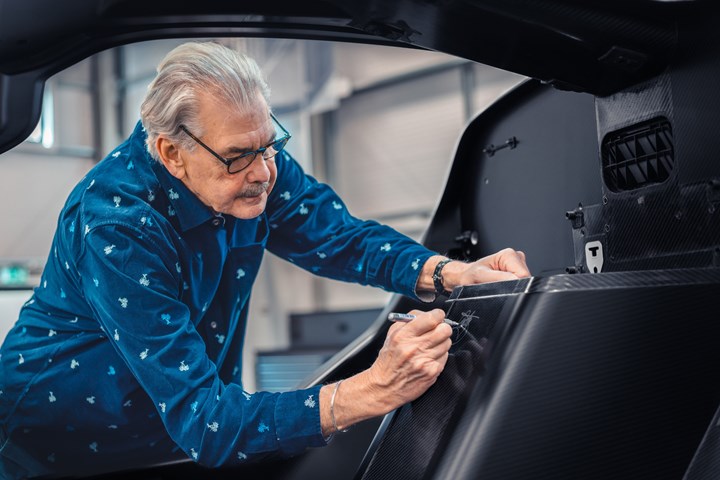
Legendary automotive icon—who is still creating amazing vehicles—signs his work. (Image: Gordon Murray Automotive)
You might look at that picture and think: “Who is that guy and what is he doing?”
And more to the point: “Why is that picture even here?”
Well, that’s not just any guy, but Gordon Murray, CBE (as in “Commander of the British Empire”).
Murray is a legend in Formula One From 1969 to 1990 he was Technical Director for, first, Brabham, then McLaren Racing. In his time with the teams he was involved in 50 overall Grand Prix wins. At Brabham there were two world championships (1981 and 1983) and three with McLaren (1988, 1989, 1990).
He left F1 and went on to help establish McLaren Cars Ltd., a purveyor of consumer sportscars.
Ironically (perhaps) the first project he worked on there was a car named the “F1.”
In 2007 he established Gordon Murray Design Ltd., a company that encompasses design, prototyping and development.
So that’s who he is.
But what’s he doing?
He is signing the first carbon-fiber monocoque for the first T.50 consumer car that will be hand-built built at Gordon Murray Automotive (GMA) in Dunsford, U.K.
Murray on what he describes as “the world’s most driver-centric supercar”:
“Designing and engineering the T.50 has been an incredible journey with much of the initial work completed during lockdown, so to witness the engineering art of the first customer car’s carbon-fibre monocoque ready for assembly, less than two-and-a-half years since reveal, is quite magical.”
Some Stats
- The monocoque weighs 107 kg (236 lb.)
- The naturally aspirated, 656-hp Cosworth GMA V12 weighs just 178 kg (392 lb.)
- The total car: 986 kg (2,174 lb.), or about a third what a comparable supercar weighs
Writer’s cramp?
An interesting thing to know about the T.50 beyond its approximate $3-million sticker:
There will be a total 100 examples built in the GMA Dunford plant.
Arguably, Gordon Murray could sign the monocoques of each of them without developing writer’s cramp.
///
The Overlooked Part of “Infrastructure”
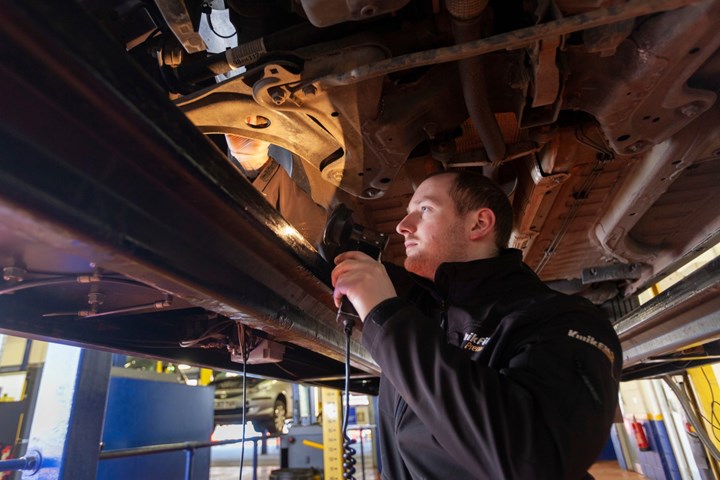
Vehicle chassis are taking an incredible beating in the U.K.--and it is undoubtedly the same in the U.S. (Image: Kwik Fix)
There were 1,677,000 new cars registered in the United Kingdom in 2021 (latest figures) according to the Ministry of Transport. That represents about 74% of all vehicles registered (with the balance ranging from light goods vehicles to buses).
All in, there are 40.3-million vehicles licensed in the U.K.
So let’s say 30 million are passenger vehicles.
Keep that in mind for this:
57% of British drivers have hit at least one pothole per week from March 2022 to March 2023 and over 13 million cars were damaged by the impact, according to the annual Pothole Impact Tracker Report from Kwik Fix, a auto service and repair company in the U.K.
What’s more, of the 13 million damaged, 2.7 million vehicles were off the road for over a week because of the extent of the required repair.
The average repair bill was £127.
But some 850,000 drivers had to pay over £300. One in four drivers under 34 had to borrow money to pay for repairs.
Hmm. . .
When people talk “infrastructure” nowadays it typically relates to building out a network of EV chargers.
But there is still the issue of simply repairing roads.
///
Liquids to Solids to Layers
Research on solid-state batteries is being conducted around the world by corporations, battery companies, universities, research centers, and probably people in their basements.
In a solid-state battery—which is said to have a higher density and likely not to explode or go up in flames—the liquid electrolyte is replaced with, as the name implies, a solid.
There are polymers, composites, oxides and sulfides that can be used. Each of these has their advantages (e.g., low costs) and disadvantages (e.g., processing difficulties).
One of the things that occurred to us is that OEMs and battery companies are investing billions of dollars into battery manufacturing facilities to produce batteries with liquid electrolytes.
We wondered about the viability of those investments if what is considered “the holy grail” of batteries is achieved: the right material(s) for solid-state batteries.
So we asked the researchers at CIC energi gune, a research organization that has been developing solid-state batteries for a decade.
Not Done
And learned that while there are a number of similarities in the processes involved in making liquid- or solid-electrolyte batteries, such as coating, mixing, assembly and more, there are still differences. However, the researchers noted:
“In order to further reduce costs in battery production, it will be necessary to move to cheaper and more sustainable processes. Solvents will disappear, and everything will be processed in dry processing, which is particularly relevant for the cathode in liquid electrolyte batteries.
“In any case, it is quite possible that the gigafactories will need to be able to constantly evolve their processes, otherwise, they will run the risk of no longer being able to cut costs.”
Which is to say that these brand-new (or still-being-built) plants are likely going to require continuous change.
And Possibly More
According to the research organization, because there are challenges regarding ionic conductivity and compatibility with high-voltage/energy cathodes with solid-state batteries that need to be addressed, they are conducting research on other approaches:
- Hybrid solid electrolytes (HSE). Here there are polymeric and inorganic electrolytes combined. The combo is said to overcome the ionic conductivity issue while providing reduced interfacial resistance between the electrolyte and electrode. Also, HSE features high mechanical robustness and processes well.
- Dual-layer electrolytes. The electrolyte consists of different electrolytes, each tailored to address a specific issue. For example, one may improve ionic conductivity, while another protects from the deleterious effects of high voltages.
The point is: Battery development continues to advance. It is far from being complete.
///
VW ID. 2all: What They Said

Will this become the “people’s EV”? The VW ID. 2all concept aims at a price of <25,000 €, or around $27,000, which clearly makes it more accessible to a wider public than most EVs available. (Image: VW)
Volkswagen Group is amping up its investments in electric vehicles, announcing last week that it is investing 180 billion Euros ($193 billion) over five years, with some two-thirds of the monies going for electrification and digitalization.
Also last week it showed a compact concept car, the VW ID. 2all. It is targeted at a price of <25,000 €, or around $27,000. There is an understanding in Wolfsburg that if there is going to be a proliferation of EVs—and the company says it expects 80% of its sales in Europe and 55% in North America to be EVs by 2030—there needs to be affordable offerings.
Thus the ID. 2all.
Here’s what some key VW people said about the car, which will be in production form in 2025, part of the plans to introduce 10 new EV models by 2026:
>> “The ID. 2all shows where we want to take the brand: close to the customer, top technologies and a fantastic design. We are implementing the transformation at pace to bring electric mobility to the masses.”--Thomas Schäfer, CEO of Volkswagen Passenger Cars
>> “The ID. 2all will be the first MEB vehicle with front-wheel drive. We are exploiting the great flexibility offered by our modular electric drive [MEB] platform and will set new standards in terms of technology and everyday usability with the MEB Entry platform.”-- Kai Grünitz, Member of the Brand Board of Management responsible for Development
>> “The MEB’s scale effects let us inexpensively integrate technologies from higher classes into the ID. 2all. Every customer will benefit from this.”—Grünitz
>> “The production version of the ID. 2all will be a full-value electric vehicle for every day of the year. A typical Volkswagen with sufficient space and a long range so that the destination can be reached without problems, even on long journeys. Thanks to the extremely variable MEB platform, our customers will also benefit from state-of-the-art technologies in the price class around 25,000 euros. Volkswagen is once more democratising progress here. And that is also exactly our goal.”-- Grünitz
>> “The most important value for Volkswagen design is stability. A second core element of the brand is likeability. Stability and likeability – we have to achieve these two values in every respect.”-- Andreas Mindt, Head of Design
>> “The C-pillar is the backbone of the Volkswagen design. In the ID. 2all, the stability of the C-pillar initially flows from the backbone into the side body elements.”—Mindt
>> “Likeability is created by the golden ratio. This is quite simply the ratio of three fifths to two fifths. The feature line running below the window shoulder is located on exactly the golden ratio line of the ID. 2all. Both the Beetle and Golf also always followed the principle of the golden ratio.”—Mindt
~~~
Related Content
Siemens and Mahle Partner to Develop Wireless EV Charging
Mahle will contribute its experience as an automotive supplier and Siemens will use its expertise in the field of charging infrastructure to develop wireless charging stations for electric vehicles.
Read MoreDN Solutions Responds to Labor Shortages, Reshoring, the Automotive Industry and More
At its first in-person DIMF since 2019, DN Solutions showcased a range of new technologies, from automation to machine tools to software. President WJ Kim explains how these products are responses to changes within the company and the manufacturing industry as a whole.
Read MoreFord Partners With Rockwell Automation to Advance EV Program
The companies will jointly collaborate on assembly tooling designs and architectures that will increase speed to market.
Read MoreSandvik Coromant on Acquisitions: Solutions Entail More Than the Tool
A Q&A with global president Helen Blomqvist explores the cutting tool maker’s acquisition of CAM software companies and how this connects to, among other things, electric vehicles.
Read MoreRead Next
on McLaren & materials, start-up thinking, EVs & ICEs, ADAS issues, supply chain, & Prius is back in a good way
A look at a composite-intensive car. . .why legacy OEMs need a new mindset. . .don’t count out internal combustion engines yet. . .a scooter and surfboard. . .EV owners dissatisfied with service. . .ADAS still seems iffy for many. . .global supply chain concerns. . .the 2023 Prius
Read Moreon Rivian, ICEs, Three-wheelers, AI for autonomous driving, Honda Pilot
Rivian is still gaining traction. . .Renault, Geely and Amoco don’t think ICEs are done. . .three-wheelers for vastly different applications. . .Honda’s rugged SUV. . .
Read Moreon Autonomy for work sites, a car-replacing bike, & why charging a battery is like inflating a balloon
A concept Bobcat AV. . .an electric bike that can haul cargo. . .what’s important for carbon neutrality. . .an app to prevent car-train accidents. . .how to understand EV charging rates (simply). . .VW ID. 4 considered. . .what do EV buyers really consider. . .Dodge 1,025-hp engine
Read More
.jpg;width=70;height=70;mode=crop)













.png;maxWidth=300;quality=90)







.png;maxWidth=300;quality=90)


